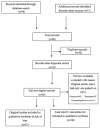Awake Prone-Positioning in Patients on Non-Invasive Ventilation for Management of SARS-CoV-2 Pneumonia: A Systematic Review
- PMID: 36004966
- PMCID: PMC9717405
- DOI: 10.3390/arm90040046
Awake Prone-Positioning in Patients on Non-Invasive Ventilation for Management of SARS-CoV-2 Pneumonia: A Systematic Review
Abstract
Introduction: Patients with corona virus disease-19 (COVID-19)-induced acute hypoxemic respiratory failure (AHRF) are often on non-invasive ventilation (NIV) and use of awake prone positioning (PP) may pose concern in terms of feasibility, efficacy and side effects. This systematic review was undertaken to evaluate the feasibility and efficacy of awake PP along with NIV in them.
Materials and methods: A systematic literature search was conducted from the inception of COVID-19 until 15 August 2021. Various factors including feasibility, interface used, outcome, efficacy, side effects and limitations in both intensive care unit (ICU) and Non-ICU setups were noted.
Results: A total of 12 original articles and six case series including 359 patients were involved. Out of it, 40% (n = 122) of patients were in ICU and 60% (n = 237) in Non-ICU areas. Four clinical studies and four case series including 114 patients had evaluated PP along with helmet continuous positive airway pressure (CPAP). All had found PP with helmet CPAP to be feasible and efficacious; however, only one study documented the sustained improvement in oxygenation i.e., 12 h after PP.
Conclusions: The present systematic review observed moderate to serious risk of bias amongst the included studies along with heterogeneity in terms of varied respiratory support amongst patients. However, the use of awake PP in patients on NIV has been found to be feasible and efficacious with no adverse events.
Keywords: COVID-19; awake prone positioning; helmet NIV; non-invasive ventilation.
Conflict of interest statement
The authors declare no conflict of interest.
Figures
Similar articles
-
Positioning for acute respiratory distress in hospitalised infants and children.Cochrane Database Syst Rev. 2022 Jun 6;6(6):CD003645. doi: 10.1002/14651858.CD003645.pub4. Cochrane Database Syst Rev. 2022. PMID: 35661343 Free PMC article.
-
Interventions for palliative symptom control in COVID-19 patients.Cochrane Database Syst Rev. 2021 Aug 23;8(8):CD015061. doi: 10.1002/14651858.CD015061. Cochrane Database Syst Rev. 2021. PMID: 34425019 Free PMC article.
-
Effect of Awake Prone Positioning in non-Intubated COVID-19 Patients with Acute Hypoxemic Respiratory Failure: A Systematic Review and Meta-Analysis.J Intensive Care Med. 2022 Nov;37(11):1493-1503. doi: 10.1177/08850666221121593. Epub 2022 Aug 25. J Intensive Care Med. 2022. PMID: 36017576 Free PMC article.
-
Home treatment for mental health problems: a systematic review.Health Technol Assess. 2001;5(15):1-139. doi: 10.3310/hta5150. Health Technol Assess. 2001. PMID: 11532236
-
Chronic non-invasive ventilation for chronic obstructive pulmonary disease.Cochrane Database Syst Rev. 2021 Aug 9;8(8):CD002878. doi: 10.1002/14651858.CD002878.pub3. Cochrane Database Syst Rev. 2021. PMID: 34368950 Free PMC article.
Cited by
-
Predictors of Non-invasive Ventilation Failure and Associated Factors Among the COVID-19 Patients Admitted to Intensive Care Unit.Anesth Pain Med. 2023 Dec 12;13(6):e140847. doi: 10.5812/aapm-140847. eCollection 2023 Dec. Anesth Pain Med. 2023. PMID: 38721438 Free PMC article.
-
Conscious prone positioning in nonintubated COVID-19 patients with acute respiratory distress syndrome: systematic review and meta-analysis.Crit Care Sci. 2024 Apr 8;36:e20240176en. doi: 10.62675/2965-2774.20240176-en. eCollection 2024. Crit Care Sci. 2024. PMID: 38597483 Free PMC article.
-
Lung re-aeration assessment by ultrasound during mechanical ventilation: Current knowledge of literature review.Multidiscip Respir Med. 2025 Jun 3;20(1):1029. doi: 10.5826/mrm.2025.1029. Multidiscip Respir Med. 2025. PMID: 40458897 Free PMC article.
-
Evaluating the Effectiveness of Noninvasive Ventilation in Patients With Acute Respiratory Failure Due to Pneumonia.Cureus. 2025 May 3;17(5):e83423. doi: 10.7759/cureus.83423. eCollection 2025 May. Cureus. 2025. PMID: 40458367 Free PMC article.
References
-
- Munshi L., Del Sorbo L., Adhikari N.K., Hodgson C.L., Wunsch H., Meade M.O., Uleryk E., Mancebo J., Pesenti A., Ranieri V.M., et al. Prone Position for Acute Respiratory Distress Syndrome. A Systematic Review and Meta-Analysis. Ann. Am. Thorac. Soc. 2017;14:S280–S288. doi: 10.1513/AnnalsATS.201704-343OT. - DOI - PubMed
-
- Bamford P., Bentley A., Dean J., Whitmore D. ICS Guidance for Prone Positioning of the Conscious COVID Patient. Intensive Care Society; London, UK: 2020.
Publication types
MeSH terms
LinkOut - more resources
Full Text Sources
Medical
Miscellaneous




